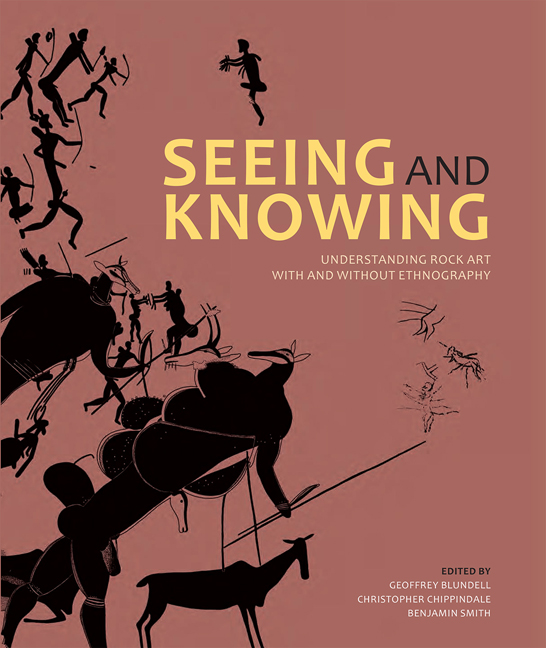Book contents
- Frontmatter
- Dedication
- Contents
- Contributors
- Acronyms
- Chapter 1 Rock art with and without ethnography
- Chapter 2 Flashes of brilliance: San rock paintings of heaven's things
- Chapter 3 Snake and veil: The rock engravings of Driekopseiland, Northern Cape South Africa
- Chapter 4 Cups and saucers: A preliminary investigation of the rock carvings of Tsodilo Hills, northern Botswana
- Chapter 5 Art and authorship in southern African rock art: Examining the Limpopo-Shashe Confluence Area
- Chapter 6 Archaeology, ethnography, and rock art: A modern-day study from Tanzania
- Chapter 7 Art and belief: The ever-changing and the never-changing in the Far west
- Chapter 8 Crow Indian elk love-medicine and rock art in Montana and Wyoming
- Chapter 9 Layer by layer: Precision and accuracy in rock art recording and dating
- Chapter 10 From the tyranny of the figures to the interrelationship between myths, rock art and their surfaces
- Chapter 11 Composite creatures in European Palaeolithic art
- Chapter 12 Thinking strings: On theory, shifts and conceptual issues in the study of Palaeolithic art
- Chapter 13 Rock art without ethnography? A history of attitude to rock art and landscape at Frøysjøen, western norway
- Chapter 14 ‘Meaning cannot rest or stay the same’
- Chapter 15 Manica rock art in contemporary society
- Chapter 16 Oral tradition, ethnography, and the practice of north American archaeology
- Chapter 17 Beyond rock art: Archaeological interpretation and the shamanic frame
- List of figures
- List of tables
- List of publications by david Lewis-williams
- Index
Chapter 3 - Snake and veil: The rock engravings of Driekopseiland, Northern Cape South Africa
Published online by Cambridge University Press: 21 April 2018
- Frontmatter
- Dedication
- Contents
- Contributors
- Acronyms
- Chapter 1 Rock art with and without ethnography
- Chapter 2 Flashes of brilliance: San rock paintings of heaven's things
- Chapter 3 Snake and veil: The rock engravings of Driekopseiland, Northern Cape South Africa
- Chapter 4 Cups and saucers: A preliminary investigation of the rock carvings of Tsodilo Hills, northern Botswana
- Chapter 5 Art and authorship in southern African rock art: Examining the Limpopo-Shashe Confluence Area
- Chapter 6 Archaeology, ethnography, and rock art: A modern-day study from Tanzania
- Chapter 7 Art and belief: The ever-changing and the never-changing in the Far west
- Chapter 8 Crow Indian elk love-medicine and rock art in Montana and Wyoming
- Chapter 9 Layer by layer: Precision and accuracy in rock art recording and dating
- Chapter 10 From the tyranny of the figures to the interrelationship between myths, rock art and their surfaces
- Chapter 11 Composite creatures in European Palaeolithic art
- Chapter 12 Thinking strings: On theory, shifts and conceptual issues in the study of Palaeolithic art
- Chapter 13 Rock art without ethnography? A history of attitude to rock art and landscape at Frøysjøen, western norway
- Chapter 14 ‘Meaning cannot rest or stay the same’
- Chapter 15 Manica rock art in contemporary society
- Chapter 16 Oral tradition, ethnography, and the practice of north American archaeology
- Chapter 17 Beyond rock art: Archaeological interpretation and the shamanic frame
- List of figures
- List of tables
- List of publications by david Lewis-williams
- Index
Summary
DRIEKOPSEILAND
Driekopseiland, one of South Africa's most extraordinary and renowned rock engraving sites (Stow 1905; Wilman 1933; Battiss 1948; Van Riet Lowe 1952; Slack 1962; Butzer et al. 1979; Fock & Fock 1989; Morris 1990; Lewis-Williams & Blundell 1998), has puzzled researchers for more than a century. Situated on exposed glaciated andesite basement rock in the bed of the Riet River, and between high (10 m–15 m) banks of Quaternary gravel and silt sediment, it is indeed quite singular: some 3600 images, on expanses of rock submerged during floods, have been accounted for, more than 90 per cent of which are ‘geometric’ motifs (Figures 3.1–3.3). Geometric images are present, and often common, at a significant number of engraving sites in the region (Fock 1969; Fock & Fock 1989), but nowhere in the area do they occur in such numbers and density relative to figurative engravings. Because of this difference, the question of authorship has arisen in the past in partial explanation of the site – with the most likely candidates cited in the literature being either ‘San’/‘Bushmen’ or ‘Khoekhoe’/‘Korana’. There is as yet no agreement on the identity/ies of those responsible for the engravings at Driekopseiland.
There has been no dearth of interpretive possibilities put forward for the site, including those entertaining ancient exotic involvement. Van Riet Lowe (1952: 770) explored the possibility that some of the engravings, evincing a “feeling for writing”, were more than mere pictographs, and Willcox (1963, 1964) wondered about resemblances to child art; but most early accounts were concerned with the authorship issue.
Research from the 1960s was increasingly concerned with a quantitative definition of the site, and to appreciate it within the emerging cultural and environmental history of the region. The site does appear to span, in part, the last 2000 years, a period of widespread change, when new trajectories become apparent in the rock art traditions of other parts of southern Africa (Parkington 1996; Dowson 1998; Jolly 1998). In this context it is relevant to enquire in what ways existing art traditions might have been influenced by the appearance of new lifestyles and social groupings. It is even possible that an immigrant group might have produced a subset of the art – perhaps a tradition quite distinct from that generally referred to as ‘San art’.
- Type
- Chapter
- Information
- Seeing and KnowingUnderstanding Rock Art With and Without Ethnography, pp. 36 - 53Publisher: Wits University PressPrint publication year: 2010



